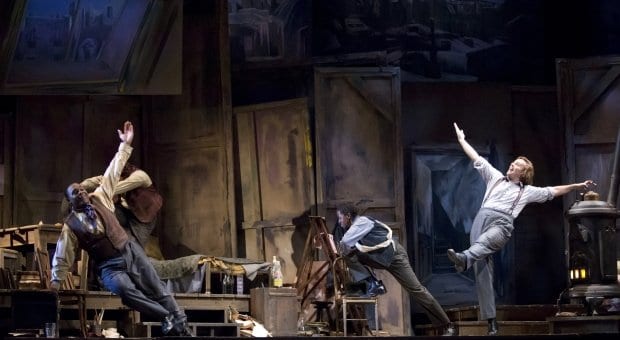Arias, overtures and parlando. Yes, opera can be intimidating for a novice. But what better reason to learn? The Canadian Opera Company has some exciting new shows this season, and Xtra‘s opera maven, Lydia Perovic, provides a preview, as well as a few tips for those readers looking to impress a date.
Be sure to check back for more Opera 101 installments.
La Bohème (1896)
Giacomo Puccini.
Libretto by Giuseppe Giacosa and Luigi Illica
Based on Henri Murger’s novel Scènes de la vie de bohème.
Conductor Carlo Rizzi, stage director John Caird.
What happens? A group of artists trying to make ends meet in Paris circa 1830s. The writer among them, Rodolfo, falls in love with Mimì, the consumptive seamstress, while the painter Marcello is intrigued by Musetta, who is a singer when not dating wealthy men who can be induced to pay the bills for her and her friends. By the end of Act 3 both pairs are separated — Rodolfo encourages Mimì to find a man who can provide for her, and she eventually obliges — but we see them all reunited at the garret for the final tragic act.
How much is the lead soprano tortured? It’s Puccini, so, count on it. The suffering soprano is paired with her opposite, the funny and fast girl soprano who remains unscathed. But we are not entirely in the domain of the oldest chimera of male creators who don’t really know how to write female characters, the saint-versus-whore dichotomy. Mimì has a profession, a degree of independence and makes tough choices. Her disadvantage is that she is already terminally ill the moment we meet her. A recent Norwegian production put this aspect of the opera up front and set the proceedings in a cancer ward with scenes from the previous life pouring in, with Mimì’s slow death de-glamourized to the maximum. Not this COC production, which looks fairly traditional. But whether the production is literal or experimental, steering Mimì clear from the one-note suffering angel toward a real character remains the challenge to be solved by the lead soprano.
Why you should go. It’s a rare opera of the standard repertoire where almost all the characters are poor — and almost all of them artists. Many of the scenes revolve around paying rent, getting a meal, buying a good piece of clothing or having to pawn it off. (La Bohème is probably the only opera with an arietta to an overcoat: the fledgling philosopher Colline sings “Vecchia zimarra” to his own as they part ways in Act 4.) La Bohème’s cultural resilience is remarkable: not only is it to this day one of the most performed operas of all times, it’s also one that has vastly expanded into other forms — musical, spoken theatre, TV, film and even contemporary literature. Luigi Comencini made a film out of the Puccini opera in 1988 with soprano Barbara Hendricks and tenor José Carreras as principals. La Vie de Bohème text has seen many different adaptations, ranging from King Vidor’s 1926 silent film with Lillian Gish to Aki Kaurismäki’s 1992 feature that brings the story up to date, with Rodolfo forced to leave France due to immigration problems. The musical Rent is based on La Bohème, and so is Charles Aznavour’s song of the same title. Lucy Ellmann’s recent novel Mimi rewrites the protagonist as a healthy, capable, fast-talking dame who does not require saving.
What to look for in the music? It’s one set-piece aria after another, but most vocal fireworks go to the principal soprano, with her introductory “Mi chiamano Mimì” and her later farewell to Rodolfo, “Donde lieta usci.” The tenor gets the spotlight at many a turn (best known is “Che gelida manina,” when he just meets Mimì), Musetta gets her big entrance song, and there are duos and ensembles. Puccini also attaches musical motives to different characters, and even Café Momus has one.
What kind of date to bring? This is a perfect outing for an opera novice. Also for people who either liked or hated Woody Allen’s Midnight in Paris. While the film criticizes the nostalgic approach to art, it is also trades heavily in it. Many productions of La Bohème have to deal with the same issue. The opera will also appeal to anybody who can use some destressing — the snow-covered streets and rooftops of Act 3, for example, can be very zen. It makes you conscious of the passing of time and the changing of seasons. (Rodolfo and Mimì decide to break up in the spring, when sadness will be more manageable.)
Conversation starter at the intermission: “Why are artists now the first gentrifiers wherever they go? We used to fit in well with the ragtag and bobtail, but now we all come from middle-class homes and art schools and creative-writing programs. We ourselves are destroying the bohemia now.”
La Boheme
Thurs, Oct 3–Wed, Oct 30
The Canadian Opera Company at the Four Seaons Centre for the Performing Arts, 145 Queen St W
coc.ca

 Why you can trust Xtra
Why you can trust Xtra


